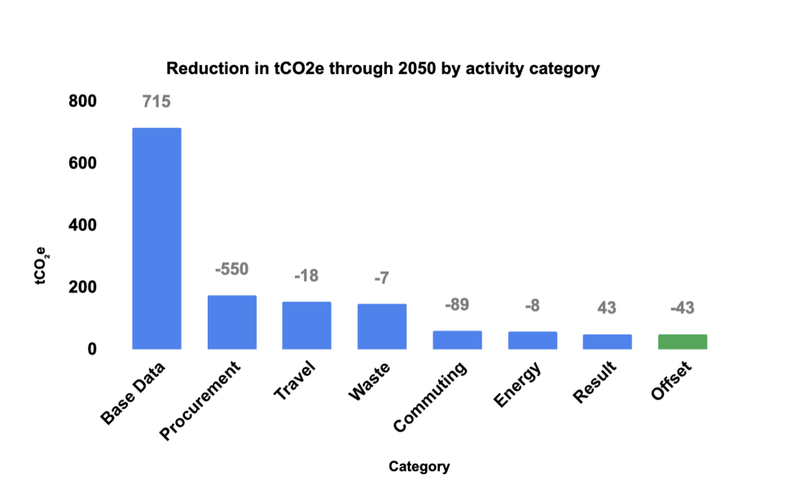Carbon Reduction Plan
Commitment to Achieving Net Zero
Peregrine is committed to achieving Net Zero emissions by 2050 in line with UK Government PPN 06/21 requirements. Given that the majority of emissions arise from our supply chain as well as employee commuting and homeworking, our reduction pathway will prioritise these areas to ensure meaningful and achievable emissions reductions.
Baseline Emissions Footprint
Baseline emissions are a record of the greenhouse gases that have been produced in the past and were produced prior to the introduction of any strategies to reduce emissions. Baseline emissions are the reference point against which our emissions reduction can be measured.
Baseline Year: 2024
Additional Details relating to the Baseline Emissions calculations. Peregrine’s baseline emissions were quantified for the reporting period 2024. Business carbon emissions have been quantified and a business carbon emissions inventory created. Significant emission sources have been identified and highlighted. Our baseline emission calculations have been prepared in accordance with the methodology of BS EN ISO 14064-1:2019; Quantification and reporting of greenhouse gas emissions and removal with guidance from the Greenhouse Gas Protocol and SECR guidelines.
The assessment quantification adheres to the Department for Environment, Food and Rural Affairs (DEFRA) guidance on quantifying and reporting greenhouse gas emissions. This assessment provides a baseline inventory against which carbon reduction achievements can be measured, monitored and reported. The quantification and analysis provided facilitates the setting of a strategic target for carbon reduction, identification of areas of focus for carbon reduction efforts and facilitates monitoring of progress towards those targets.
Emissions TOTAL (tCO2e)
Scope 1: 0.00
Scope 2: 0.00
Scope 3: (Included Sources): 715.39
(Purchased Goods and Services, Transportation and Distribution (Upstream and Downstream), Waste, Business Travel, Employee Commuting and Homeworking, Upstream Leased Assets)
Total Emissions: 715.39
Peregrine’s baseline emissions have been calculated in accordance with BS EN ISO
14064-1:2019, the Greenhouse Gas Protocol, and SECR guidelines
Current Year Emissions Reporting
Reporting Year: 2024
Emissions TOTAL (tCO2e)
Scope 1: 0.00
Scope 2: 0.00
Scope 3: (Included Sources) 715.39
(Purchased Goods and Services, Transportation and Distribution (Upstream and Downstream), Waste, Business Travel, Employee Commuting and Homeworking, Upstream Leased Assets)
Total Emissions: 715.39
Emissions Reduction Targets
Peregrine is committed to achieving Net Zero emissions by 2050.
As this is our first Carbon Reduction Plan, there are no existing carbon emission reduction targets against which to report progress. In the future we plan to implement further measures that will continue to drive down emissions, some of which are listed below

| Target Year | Absolute Emissions Reduction (%) | Key Reduction Initiatives |
| 2030 | 25% reduction | Draft policy for sustainable procurement, focussing primarily on Tier 1 suppliers to begin with. Improve circular practices, encourage lower carbon commuting practices and procure 100% renewable energy. Reduce office waste. |
| 2035 | 50% reduction | Shift focus for sustainable procurement to Tier 2 suppliers. Continued reduction in commuting and homeworking emissions. |
| 2040 | 75% reduction | Final phase of commuting emissions reduction, draft business travel policy |
| 2050 | Net Zero | Final phase of supply chain engagement as well as reducing business travel. Offsetting remaining hard-to-abate emissions (<10%) |
We have identified a number of initiatives which will support reduction of emissions in these areas, in line with the required levels of abatement recommended by the Science Based Targets initiative (SBTi).
Carbon Reduction Initiatives
As all of Peregrine’s emissions sit in Scope 3, we will be focussing on the below key areas to decarbonise by 2050.

Completed Carbon Reduction Initiatives
Peregrine has taken proactive steps toward reducing its carbon footprint by implementing the following initiatives thus far:
● A cycle-to-work scheme which encourages employees to opt for a greener,
healthier commute, reducing emissions associated with daily travel
● The introduction of an electric vehicle (EV) scheme further supports
low-emission transport, offering staff an environmentally friendly alternative
to traditional petrol and diesel vehicles
● A comprehensive procurement policy aimed at embedding sustainability
into our supply chain. This policy will prioritise environmentally responsible
sourcing, helping to minimise the indirect carbon impact of purchased
goods and services
● An energy champion has been appointed for each of the facilities
● The company has maintained a virtual-first approach, encouraging all
employees to work from home where possible. This strategy is supported by
our business travel and events policy, which helps manage in-person
activities, and is reinforced by ongoing investment in our IT infrastructure.
Proposed Carbon Reduction Initiatives
| Proposed Carbon Reduction Initiatives | Contribution to Reduction | Contribution to Reduction |
| Sustainable procurement policy for Purchased Goods & Services | Reduce supplier emissions by 40%, contributing to ~32% absolute emissions reduction. | 2035 |
| Supplier engagement & low-carbon procurement programme | Shift to sustainable suppliers to cut supply chain emissions by 30%,contributing to ~24% absolute reduction | 2040 |
| Increase Use of Circular Economy practices | Reuse & refurbish equipment to lower emissions from purchased goods by 15%, contributing to ~12% absolute reduction | 2028 |
| Work with office management to procure 100% renewable electricity | 100% renewable electricity adoption, reducing energy emissions by 90%,contributing to ~0.9% absolute reduction | 2030 |
| Improve office energy efficiency | Reduce energy waste by 30%,contributing to ~0.3% absolute reduction | 2026 |
| Optimise homeworking energy efficiency support | Encourage energy-efficient home offices, reducing homeworking emissions by 25%, contributing to ~3.25% absolute reduction | 2045 |
| Low-carbon commuting policies | Reduce commuting frequency & promote green transport, cutting commuting emissions by 30%, contributing to ~3.9% absolute reduction | 2030 |
| EV & public transport incentives for commuters | Increase EV adoption & public transport usage, reducing commuting emissions by 40%, contributing to ~5.2% absolute reduction | 2030 |
| Reduce business travel | Cut flights by 50% through remote collaboration, reducing absolute emissions by ~1.7% | 2050 |
| Switch to low-mission business travel options | Increase train & EV transport for business travel, reducing absolute emissions by ~0.9% | 2030 |
| Zero-waste office strategy | Reduce landfill waste, cutting waste emissions by 50%, contributing to ~0.5% absolute reduction | 2028 |
| Sustainable office supplies & digitalisation | Reduce paper use & digitise processes, cutting absolute emissions by ~0.5% | 2030 |
Further Initiatives that will support our Net Zero Targets:
● We recognise that high-quality data is fundamental to effective carbon reduction. Over the coming years we aim to improve data and reporting to improve accuracy of our carbon accounting in future years, aligning with best practices under ISO 14064. We will explore data collection tools to facilitate this and conduct third-party audits of our emissions data, as well as establishing governance for our emissions data collection.
● We aim to implement an Environmental Management System (EMS) certified to ISO14001 standards to support the implementation and monitoring of carbon reduction measures. This will support the systematic planning, implementation, monitoring, and continuous improvement of our carbon reduction initiatives
● Recognising that some emissions may be unavoidable, we have committed to high-integrity carbon offsetting schemes as part of our long-term Net
Zero strategy. This year we have offset 21% of our 2024 emissions through funding The International Small Group and Tree Planting Program – an afforestation project in Uganda. This project aligns with the Voluntary Carbon Markets Claims Code of Practice as well as the Integrity Council for the Voluntary Carbon Markets.
● Training and Engagement:
To encourage a culture of sustainability within Peregrine, we will engage our employees and partners with the below:
○ Carbon literacy and reduction training to ensure awareness of
objectives, targets and responsibilities for performance improvement
○ Internal and external communication with key stakeholders to
promote engagement with our carbon reduction initiatives and
performance.
Declaration and Sign Off
This Carbon Reduction Plan has been completed in accordance with PPN 06/21 and associated guidance and reporting standards for Carbon Reduction Plans.
Emissions have been reported and recorded in accordance with the published reporting standard for Carbon Reduction Plans and the GHG Reporting Protocol
corporate standard and uses the appropriate Government emission conversion factors for greenhouse gas company reporting.
Scope 1 and Scope 2 emissions have been reported in accordance with SECR requirements, and the required subset of Scope 3 emissions have been reported in
accordance with the published reporting standard for Carbon Reduction Plans and the Corporate Value Chain (Scope 3) Standard 3.
.
This Carbon Reduction Plan has been reviewed and signed off by the board of
directors (or equivalent management body).
Signed on behalf of the Supplier:
………………………………………………………………….
Date: …25 March……………….……….
Signed on behalf of Furthr Ltd
